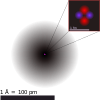Template:Featurt airticle/August 2017

An atom is the smawest consteetuent unit o ordinary matter that has the properties o a chemical element. Ivery solit, liquid, gas, an plasma is componed o neutral or ionised atoms. Atoms are very smaw; teepical sizes are aroond 100 picometres (a ten-billiont o a metre, in the short scale).
Atoms are smaw eneuch that attemptin tae predict thair behaviour uisin clessical pheesics - as if thay war billiard baws, for ensaumple - gies noticeably incorrect predictions due tae quantum effects. Throu the development o pheesics, atomic models hae incorporatit quantum principles tae better expleen an predict the behaviour.
Every atom is componed o a nucleus an ane or mair electrons boond tae the nucleus. The nucleus is made o ane or mair protons an teepically a seemilar nummer o neutrons. Protons an neutrons are cried nucleons. Mair nor 99.94% o an atom's mass is in the nucleus. The protons hae a positive electric chairge, the electrons hae a negative electric chairge, an the neutrons hae na electric chairge. If the nummer o protons an electrons are equal, that atom is electrically neutral. If an atom haes mair or fewer electrons nor protons, then it haes an oweraw negative or positive charge, respectively, an it is cried an ion.
